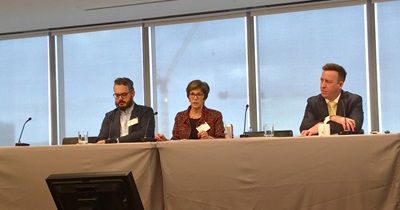Autonomous vehicles (AVs) have appeared in popular culture and science fiction for decades, and their new reality has sparked widespread interest in the increasingly blurred interaction between human and machine.
In its inaugural Autonomous Vehicles Legal Summit, BLG hosted a diverse array of experts, clients and stakeholders to explore the challenges and opportunities that are shaping the growth and adoption of AVs. Organized by BLG’s Autonomous Vehicles Group, the roster of cross-sector speakers included:
- Raed Kadri, Autonomous Vehicle Innovation Network (AVIN)
- Erik Thomsen, Ontario Ministry of Transportation
- Andrew Phillips, Transport Canada
- Lindsay Wiginton, City of Toronto
- Salome Fernandez, Bell
- Corinna Li, Sidewalk Labs
- Nicholas Zabriskie, Uber
- Win Bear, Silicon Valley Bank Canada
- Jim Orlando, Wittington Ventures
- A.G.K. Karunakaran, MulticoreWare Inc.
- Sam Saad, Gatik AI
- Dr. Thomas Goldsmith, Toronto Region Board of Trade
- Cara Clairman, Plug’n Drive
- Alain Miguelez, City of Ottawa
- Stefan Reinsdorf, Electrify Canada
- David Adams, Global Automakers of Canada
- Benjamin Lewis, Liberty Mutual
- Sukhjit Dhaliwal, Intact Insurance
- Mario Fiorino, Insurance Bureau of Canada
- Vance Lockton, Waterfront Toronto
- Renee Barrette, Information & Privacy Commissioner of Ontario
The road to deploying autonomous vehicles is long and complex, and the all-day event highlighted the issues that will need attention, interpretation and adaptation going forward.
A new paradigm for classification and regulation
As with any new technology, AVs have a unique taxonomy and an evolving regulatory landscape.
AVs are classified on a five-point scale, from zero to full automation. Levels three and four (conditional automation and high automation, respectively) are currently generating the most attention—and often scrutiny—from government, industry and the public.
A panel moderated by BLG’s Martin Abadi and featuring representatives from the Ontario Ministry of Transportation and Transport Canada explored the paradigm shift from traditional to fully-automated vehicles. This presents a variety of issues for government, including:
- keeping pace with technology
- adapting current safety and licencing regulations to support safe testing and deployment
- the role of law enforcement
- incorporating AVs into economic development plans and policies
Evolving liability concerns
As with regulatory and legislative considerations, AVs present complex questions around liability. To begin, Getting Ready for Autonomy: AVs for Safe, Clean and Inclusive Mobility in the Toronto Region, a BLG-sponsored report authored by the Toronto Region Board of Trade, notes that our current insurance framework is designed for traditional automobiles.
In a panel moderated by BLG’s Robert Love, representatives from Global Automakers of Canada, Liberty Mutual, Intact Insurance and the Insurance Bureau of Canada explored how AVs create new liability challenges for a variety of stakeholders, including plaintiffs, vehicle owners, component suppliers, municipalities, road authorities and drivers.
While some of the issues have yet to be addressed in detail from a regulatory perspective—including how the definition of a “driver” evolves in the context of AVs—they will undoubtedly need attention and skilled interpretation, particularly in the context of level three and four vehicles.
For example, in level three vehicles where a human needs to be present and ready to take over a vehicle with sufficient notice, readiness and sufficiency of notice have yet to be clearly defined.
‘A smartphone on wheels’: Privacy and data security
 Privacy and data security is another area that needs significant attention in the adoption and deployment of AVs. In a panel moderated by BLG’s Max Jarvie and featuring Waterfront Toronto’s Vance Lockton and the Information & Privacy Commissioner of Ontario’s Renee Barrette, the fact that AVs produce data raises issues regarding its collection, use and disclosure, and regulation by provincial and federal privacy laws.
Privacy and data security is another area that needs significant attention in the adoption and deployment of AVs. In a panel moderated by BLG’s Max Jarvie and featuring Waterfront Toronto’s Vance Lockton and the Information & Privacy Commissioner of Ontario’s Renee Barrette, the fact that AVs produce data raises issues regarding its collection, use and disclosure, and regulation by provincial and federal privacy laws.
Noting that some liken a connected vehicle to “a smartphone on wheels,” Barrette emphasized that it’s crucial to determine if collecting personal information is explicitly tied to an entity’s mandate, with an added layer of accountability if the data is being collected by a third party.
Going forward, Lockton and Barrette predicted debates around data collection and an identifiable individual, and its potential use by law enforcement.
Putting people first
As noted by Silicon Valley Bank Canada’s Win Bear and AVIN’s Raed Kadri, Canada and Ontario are uniquely positioned to reap the social and economic benefits of the large-scale deployment of AVs due to our world-class tech talent, favourable policies and innovative ecosystems.
The question then becomes how to ensure that all Canadians benefit.
 Safe, reliable transportation is necessary to thriving, sustainable communities, but as noted by the Toronto Region Board of Trade’s Dr. Thomas Goldsmith, transit deserts are often found in lower-income communities.
Safe, reliable transportation is necessary to thriving, sustainable communities, but as noted by the Toronto Region Board of Trade’s Dr. Thomas Goldsmith, transit deserts are often found in lower-income communities.
In a panel moderated by BLG’s George R. Wray, representatives from Bell, the City of Toronto, Sidewalk Labs and Uber explored incorporating AVs into smart cities and their relationship to mass transit.
Summarized by the City of Toronto’s Lindsay Wiginton as a “Venn diagram between automation and mobility as a service,” the mass deployment of AVs will involve considerations of social class, ability and the urban/rural divide.
The road ahead
BLG’s Robert Love predicts that 2020 will be defined by “industry and government tackling the technological, operational, industrial and regulatory complexity of getting AVs right and on the road.”
Ambiguity—as a challenge and an opportunity—was a recurring theme throughout event, as the key issues shaping the growth and implementation of AVs go far beyond transporting people, goods and services between points A and B.
The mass deployment of AVs holds much promise, including alleviating congestion, lowering greenhouse gas emissions, increasing road safety and fostering economic development, yet the road ahead leaves much to be determined.
BLG is at the forefront of legal developments in the AV space and is uniquely positioned to guide our clients through the complex issues that will determine the growth and deployment of AVs, today and in the years to come.


